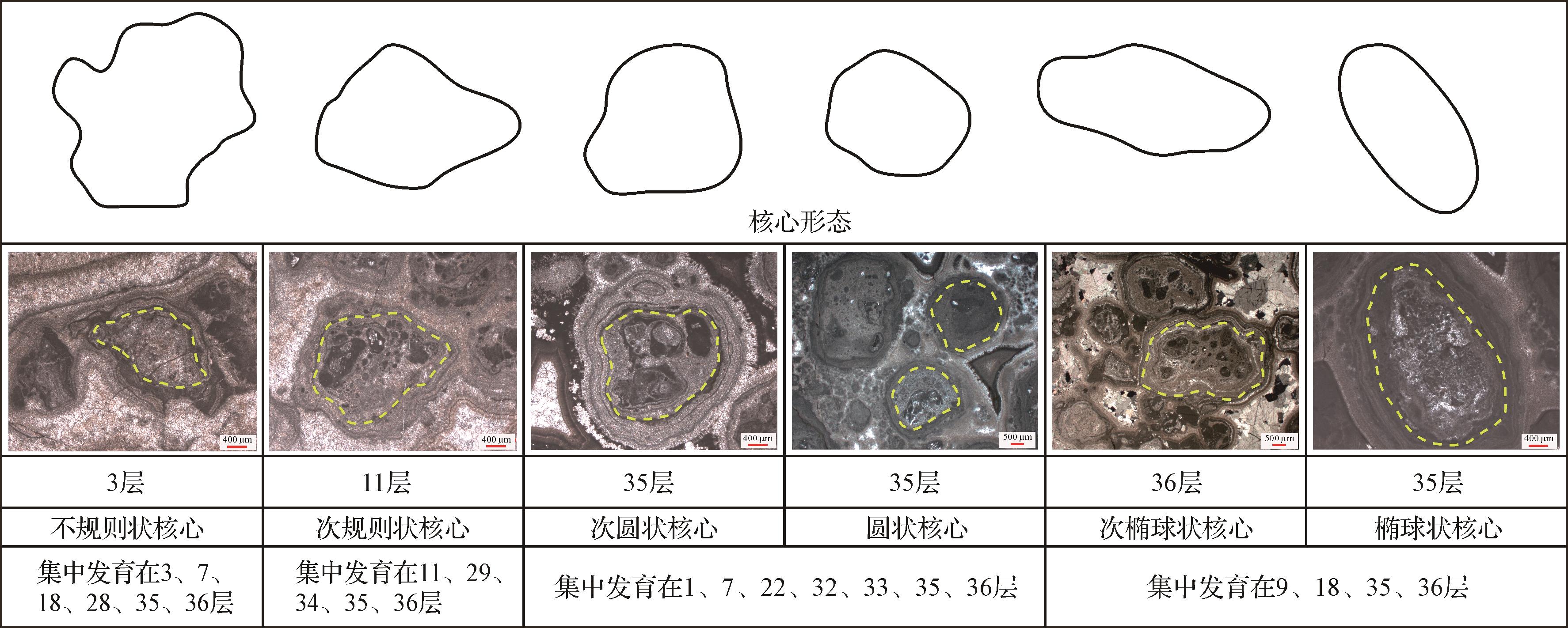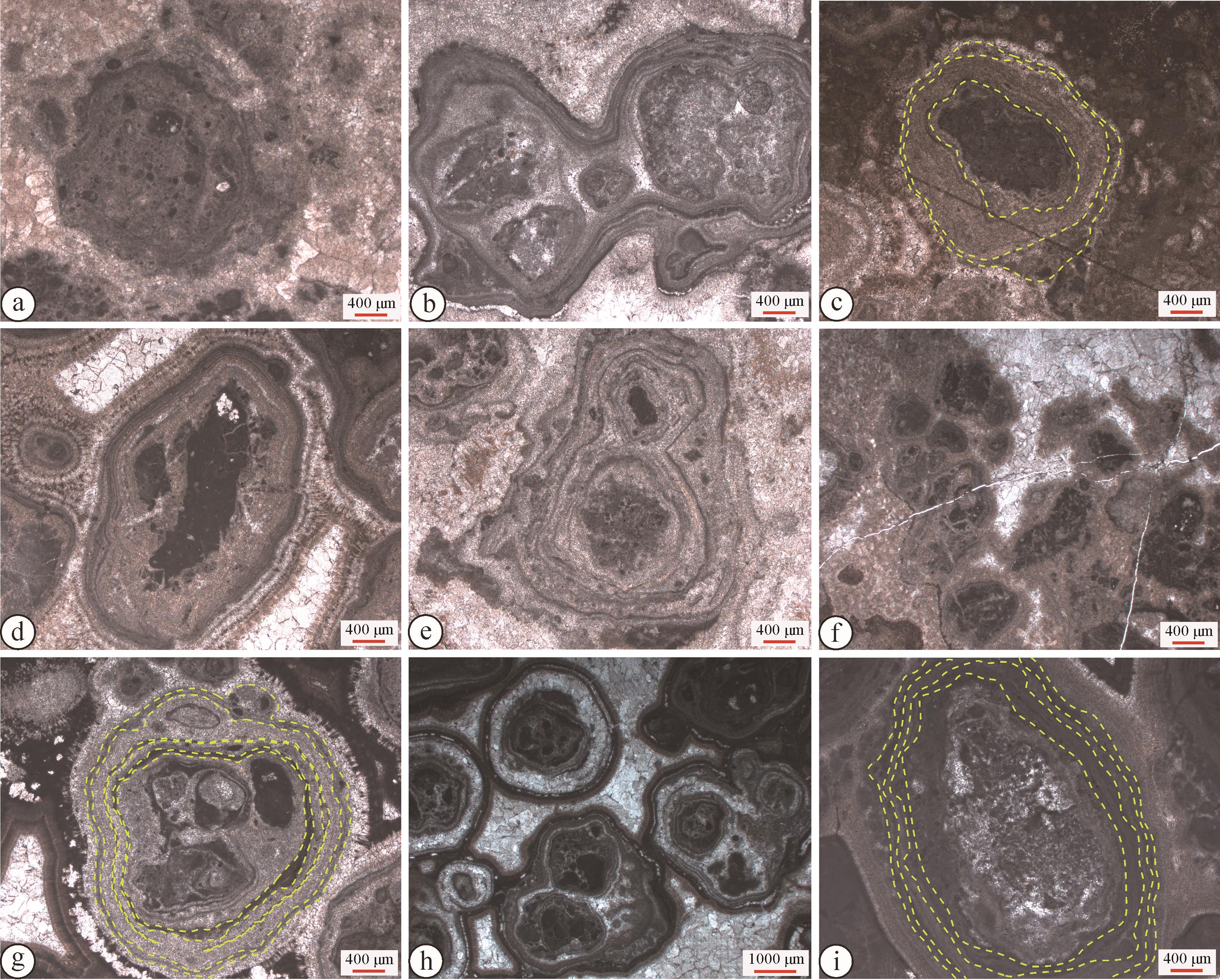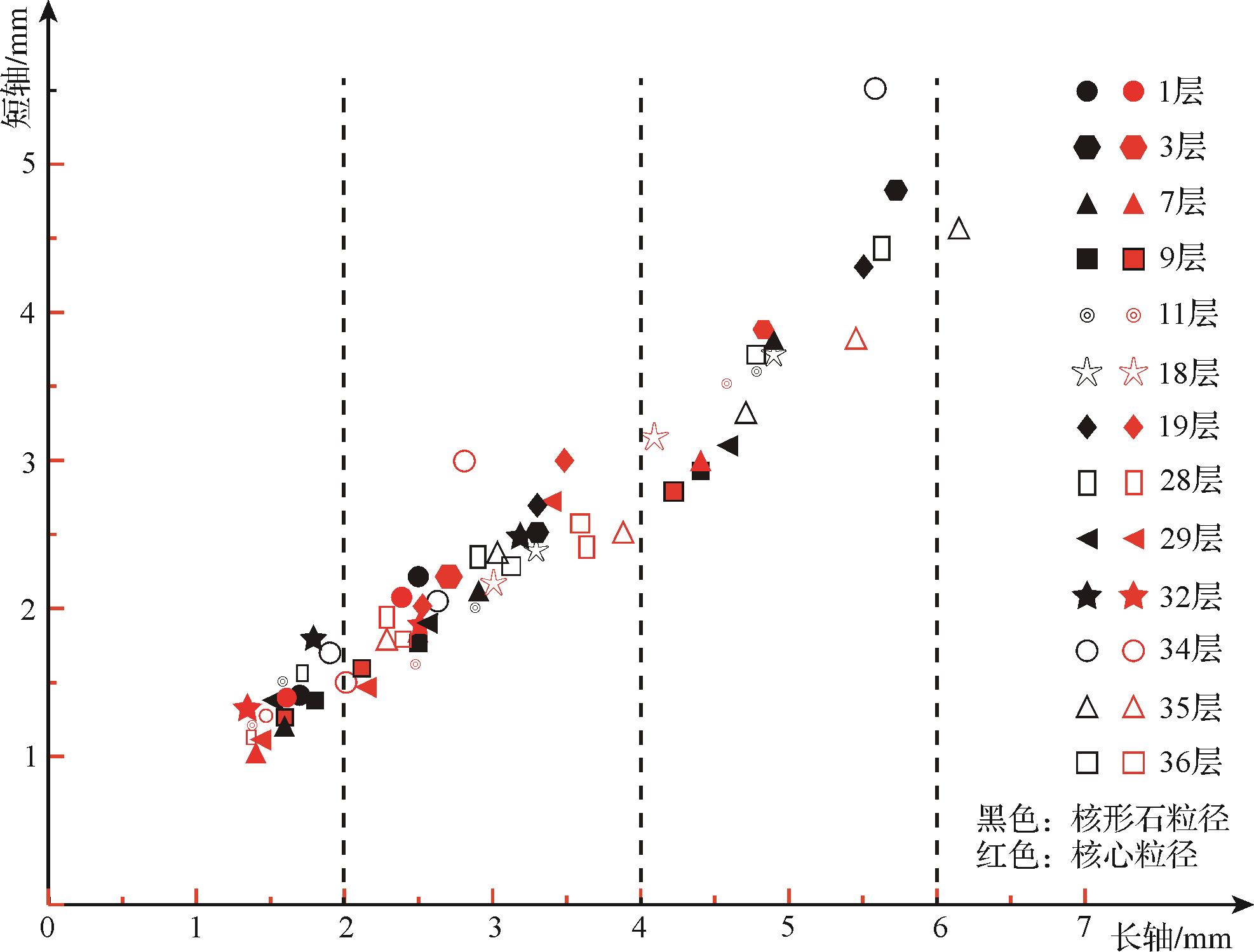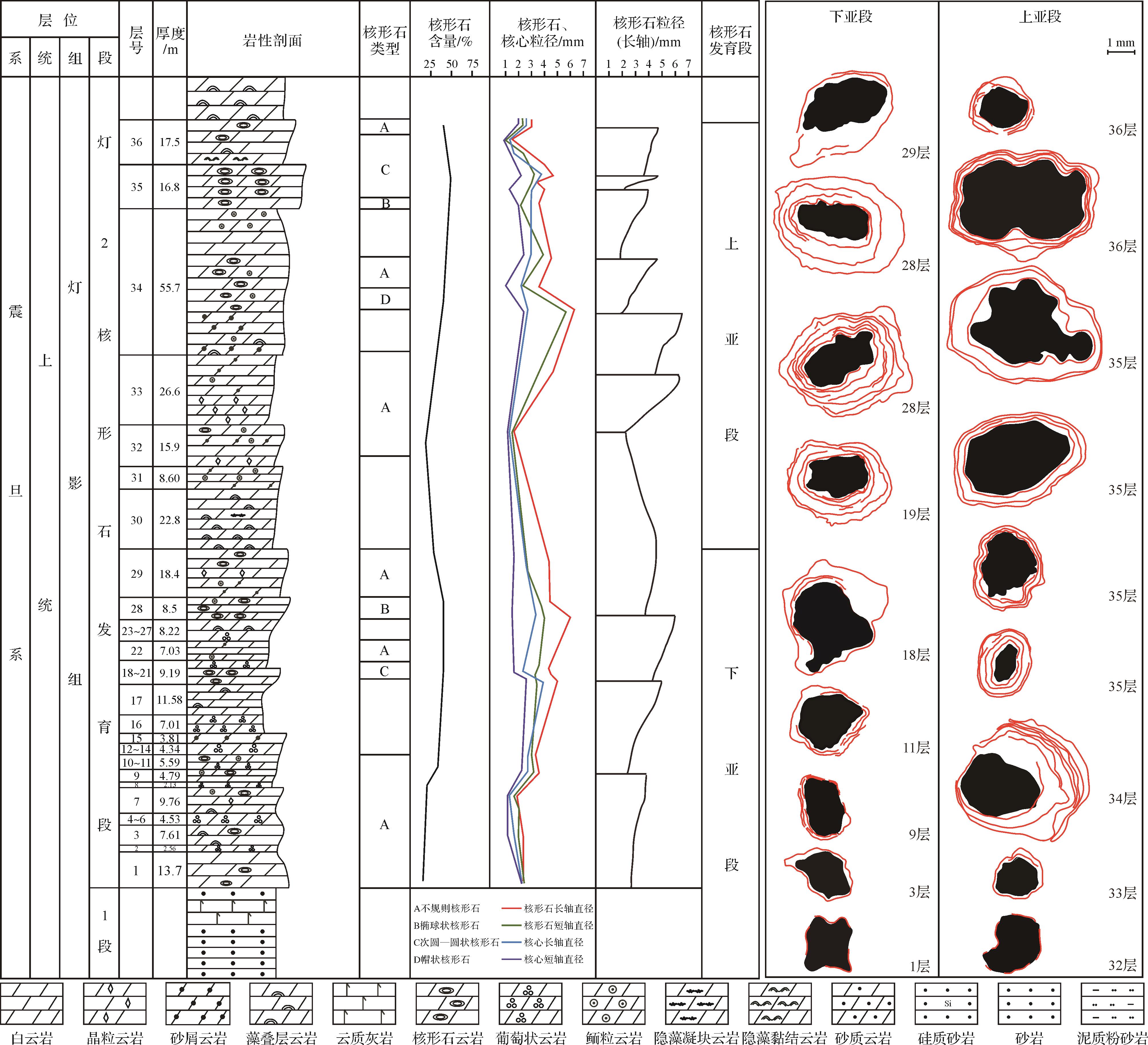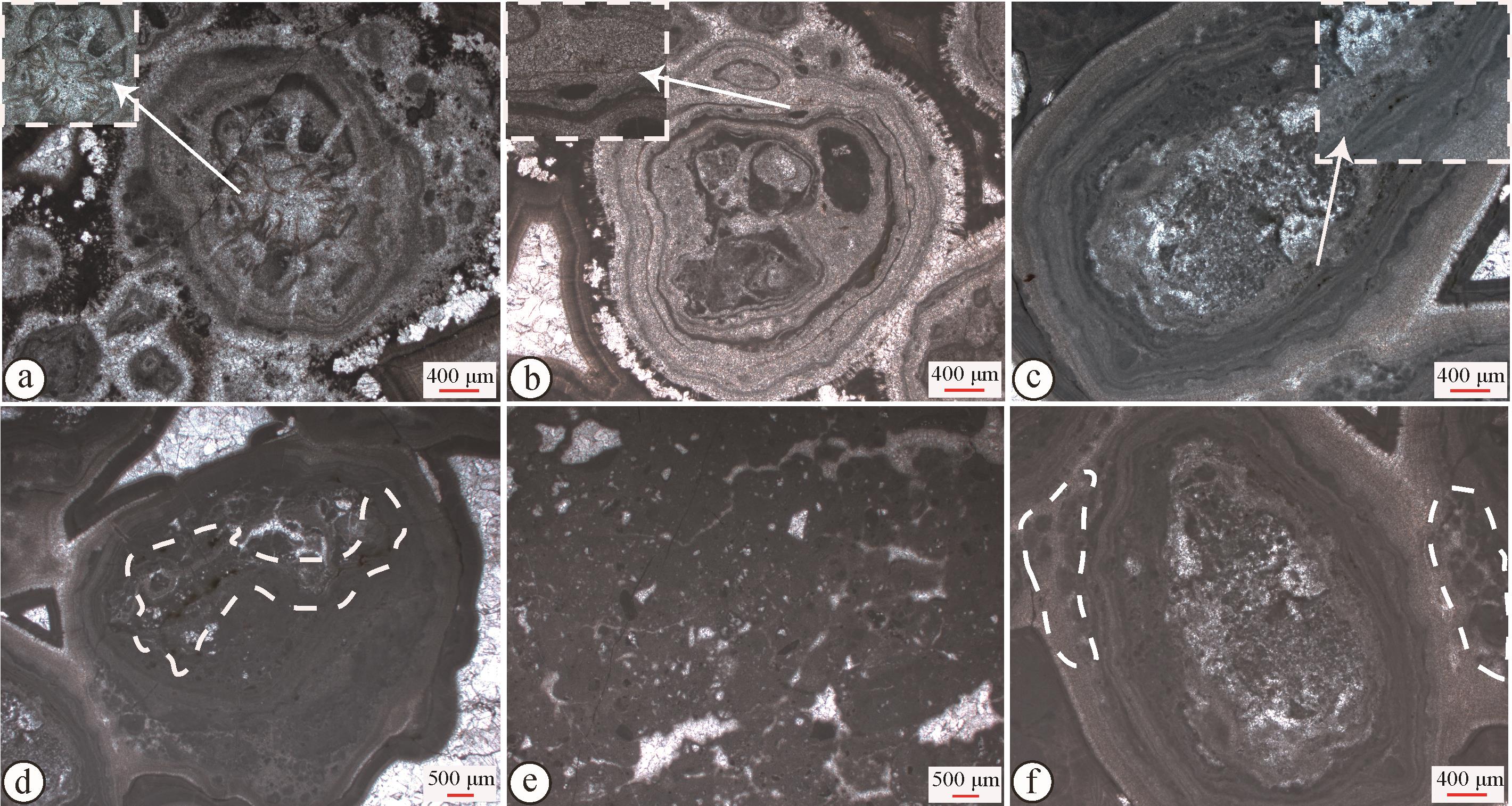HTML
-
地质记录中的核形石多是不相连的、圆形的、毫米—厘米级别大小,由骨屑和其他异化颗粒等核心和微晶质外壳组成不规则或不完整的同心纹层组成[1-5],是古气候、水体能量、水深、微生物类群、海水化学条件波动等信息的重要载体[6-13]。自前寒武—第四纪的大部分地层中均有核形石分布,但不同时期其特征及丰度具有差异性[8-9,14-18]。埃迪卡拉纪是地球演化史上的重大过渡期,发生了如海洋化学条件的剧烈波动[19-22]、早期生物的爆发式演化等[23-24]一系列事件,并对地球表层系统产生了重要影响[25];核形石组构及成因研究可有效揭示该期环境指标及变化。
国内学者对灯影组核形石形态特征描述的基础上,划分出诸如正常(复合)核形石和薄皮(复合)核形石[26]、低能球型和高能短棒型[27]等类型;成因上认为其形成与胞外聚合物(EPS)的分泌相关[26]、与蓝细菌自身生长和生长停滞期生物作用有关[27]等;研究区集中在滇东和川西南[10]、川东北[26]、燕山地区蓟县[28]等。米仓山地区埃迪卡拉纪灯影组为受陆源碎屑物质影响的局限台地沉积环境,沉积组构及微相类型多样[29],核形石组构、分类及垂向分布特征研究可为揭示该区埃迪卡拉纪古环境及演化提供参考。
-
杨坝剖面位于四川省南江县,构造上位于四川盆地北缘米仓山前缘构造带南侧,是米仓山构造带灯影组出露非常完整的剖面(图1a,b)。米仓山地区归属于扬子地台北缘,与东面的南大巴山褶皱冲断带一起共同构成位于秦岭造山带和四川盆地稳定克拉通之间的前陆褶皱冲断带,是造山带与盆地之间的过渡带,具有典型的前陆冲断褶皱带特征[31-32]。
埃迪卡拉系由下统陡山沱组、上统灯影组组成。区域上灯影组共分为四段:灯1段岩性主要为泥质石英砂岩,夹灰质白云岩,少量菌藻类云岩;灯2段发育各类藻云岩,包括葡萄石、藻屑、核形石、藻纹层等组构(图1c);灯3段岩性包括硅质石英砂岩、硅质泥晶白云岩、灰黑色硅质泥页岩等;灯4段以泥晶白云岩、硅质白云岩、藻砂屑白云岩为主,夹藻纹层白云岩[33]。一般认为灯影组沉积期四川盆地沉积水体较浅并受限,具有向东变开阔的趋势[34],沉积相类型包括台坪、潮坪及缓坡、局限台地等[35-36]。
-
杨坝剖面灯影组核形石发育段集中在灯2段(厚235.73 m),根据核形石宏观形态、大小、垂向变化等将其分为上、下2个亚段,厚度分别为109.53 m、126.2 m。其中下亚段细分为1~29层,核形石主要分布在1、3、7、9、11、18、19、28、29层,累积厚度49.5 m;上亚段细分为30~36层,核形石主要分布在32、34、35、36层,累积厚度22.6 m。剖面野外观察获取了核形石的发育位置、粒度、形状、丰度、垂向变化等指标。对密集发育段采用5 cm间距的样方取样共采集样品319块,磨制普通薄片、超大薄片计564片。采用宏微观结合的方法对核形石粒度进行统计:利用游标卡尺测量野外肉眼可见的核形石最大直径;微观上海量统计了核形石发育的13个层段、564块薄片、约3 200个核形石的粒度,虽然薄片多数未截取到核形石最大粒径,但是在大量统计数据下,具有统计学意义;数据处理采用加权平均法。薄片观察应用Zeiss AXIO SCOPE. A1偏光显微镜及VNT QuantLab-GP显微粒度分析系统。
-
核形石通常是由核心与包壳纹层两部分组成,二者相辅相成,共同决定了核形石的粒度、形态等,是核形石分类的重要依据。
-
核心组分类型多样,常见泥晶团块、藻砂屑、砾屑、斑晶等,并可见先期形成的核形石碎片、藻丝体和莓状黄铁矿(图2)。成分以白云石为主,少量黄铁矿、陆源碎屑。形态包括不规则状、次规则状、次圆状、圆状、次椭圆状、椭圆状,以次圆状、次规则状、次椭圆状为主。核心粒径通常为1~4 mm,部分可达6 mm以上,一般占核形石的2/3~3/4。按核心直径,将其分为小核心<2 mm、中核心2~4 mm、大核心>4 mm;其中小核心形状多呈次圆、圆状、少量不规则,组分多为砂屑、微泥晶团块;中核心形状为次规则、次圆状,组分以砂屑、微泥晶团块、早期的核形石碎片、少量藻丝体为主;大核心形状多为次规则、次椭圆状,组分以砂屑、早期的核形石碎片为主,核心大小与核心形状有较强的耦合关系,如次椭圆状核形石的出现,其核心往往多为大核心。核形石整体形态与核心形态呈明显正相关,但随着纹层厚度增大,其正相关性逐渐减弱。
下亚段:核心组分包括砂屑、微泥晶团块、早期的核形石碎片等,核心粒径通常1~4 mm,部分可达5 mm以上,通常占核形石的2/3~3/4。自下而上,核心粒度整体具先变大后变小趋势,下部多小核心、中核心,中部出现大核心,上部为中核心。下部核形石核心为小核心<2 mm,形态为次圆状、次规则状,中上部核形石核心为大核心>4 mm,形态变为次椭球状至次规则、次圆状。
上亚段:核心组分包括砂屑、藻砂屑、微泥晶团块、早期的核形石碎片等,粒径1~4.5 mm,通常占整个核形石的1/2~2/3。自下而上,核心粒度整体亦具先变大后变小趋势,即下部为小核心,中部出现大核心,上部为少量的小核心。下部核形石核心形态为次圆状、次规则状,上部核形石核心形态为次圆状、次椭球状、次圆状。
-
壳层具由富藻暗层和富屑亮层相间组成的同心圈层结构,且整体亮层厚、暗层相对较薄[37]。内圈暗层宽50~500 μm,多数50~200 μm,外圈暗层宽20~250 μm,多数20~100 μm;内圈亮层宽30~300 μm,多数30~200 μm,外圈亮层宽70~750 μm,多数100~350 μm。内圈暗纹层颜色较深、清晰,纹层内部可见暗色砂屑和暗色泥晶团块,沿包壳方向发现莓状黄铁矿的存在,可能为SRB(硫酸盐还原细菌)在厌氧环境下的产物,内圈暗纹层多为规则泥晶纹层和不规则状波状纹层;外圈暗纹层颜色稍浅、模糊,似漂浮、弥散于基体之中,整体呈弥散状至平滑状,为藻依靠光合作用吸附和捕获碳酸盐质点而形成,常见浅色砂屑的沉积,这种局部沉积附着在暗纹层上缠绕发育最终呈凸状集合体,导致暗纹层整体呈波状起伏,局部厚度增大,单层厚度不均匀,外圈暗纹层多呈不规则波状、断续状泥晶纹层(图3)。
下亚段:下部壳层往往发育1~2层纹层,纹层常为不规则波状、不规则断续状泥晶纹层,以薄皮核形石、弥散粒为主(图3a);中部壳层连续、规则(图3b);上部核心变小,纹层不规则(图3c)。下亚段核形石壳层中规则的明暗纹层常见两种发育方式:明暗纹层密集且厚度均较窄和仅明亮层单层厚度增厚的细而平直的纹层(图3b,d)。第一种壳层发育方式,常见于灯2段核形石发育段下亚段的中下部(第7层上部以早期核形石碎片为复合核心的核形石和第18层上部以微泥晶团块、砂屑为核心的椭球状核形石),第二种壳层发育方式,其明暗纹层内部沉积有砂屑等颗粒(图3e),常见于灯2段核形石发育段下亚段上部(第19层下部的以早期的核形石碎片为核心的核形石和第28层以砂屑、砾屑为核心的椭球状核形石)。根据核形石形态、组分、核心粒径与核形石包壳特征的总结对比发现:第7层和第19层核心成分均为早期的核形石碎片,核心粒径均为>4 ㎜大核心,但是纹层发育特征不同,后者明亮层明显增厚,第18层和第28层核形石和核心形状均为椭球状,组分类似,核心均为>4 mm大核心,纹层发育特征亦不同,后者明亮层增厚。这两者特征差异发育说明在灯2段核形石发育段下亚段从下往上,水动力逐渐增加。明显的壳层厚度差异应该与核形石包壳形成过程中水体持续时间相关,中高能动荡水体持续时间越长,形成明亮层厚度更厚。
上亚段:下部多为小核心,包壳仅为1层或2~3层不规则断续状、波状泥晶纹层(图3f);中上部出现大量的大核心,3~4套包壳,纹层为规则泥晶纹层,明暗纹层分界清楚,单层厚度稳定(图3g);上部核心变小,包壳发育较差(图3h)。核形石自身和核形石之间藻类黏结痕迹显著,纹层内部、之间常见黏结细小颗粒现象,整体纹层较密集、色暗(图3i)。上亚段中上部核形石核心整体为大核心,包壳整体属于大核心—薄皮核形石;至36层下部,核形石核心变为大核心,但包壳单层厚度变厚且规则,厚度均匀,可知该期水动力逐渐增强。
-
对于次规则、次圆状的小核心,随着纹层厚度增大,最终形态可发展为次圆状、圆状,且壳纹层分布构造、连续;这可能是核心在悬浮状态下藻类受到较均匀的光照而在各个方向均匀生长,形成规则的圆形且连续的藻类纹层等[16,26]。对于次椭球状的大核心,随着纹层厚度增大,最终形态仍保持椭球状,表现为形态上相对更加规则;可能因核心过大,虽然水动力增加了,致使其在水中悬浮因藻类作用包裹缠绕形成明暗纹层,但是持续时间太短,还不至于抵消核心对其形态影响。将核形石长轴分为0~2 mm、2~4 mm、4~6 mm、6~8 mm范围,核形石整体粒径分布在1~4 mm范围内,少量分布在6 mm左右。整体上,核心粒径与核形石粒径具有良好的对应关系,并且长短轴比值较大(图4)。
-
目前核形石常用分类依据主要有“形”[1,38]、“组分”[6]、“形+成因环境”[39-40]等。灯影组常用核形石分类有以核心大小与包壳厚度分类和以核心多少分类[26]和以核形石的内部结构特征分类[41]等。各分类之间相互交叉、重复,使得核形石的分类和描述很难达到一致的标准。本文以“形”分类为主线,综合考虑核心、包壳的特征,将核形石划分为不规则状核形石、椭圆状核形石、次圆状圆状核形石、似半球状或帽状核形石。
(1) 不规则状核形石:不规则状,分布在下亚段的下部。此类核形石的核心和壳层形态均呈不规则状,暗纹层呈不规则断续状分布,核心多为藻砂屑(图5d,e)。核形石长轴直径2.5~2.8 mm,短轴直径2~2.5 mm,核心长轴直径1.6~1.75 mm,短轴直径1.2~1.4 mm,薄皮核形石为主。包壳纹层为不规则断续状泥晶纹层单层或不规则断续状泥晶纹层—亮纹层—不规则断续状泥晶纹层组合,亮纹层以微晶纹层为主。此类核形石的核心应是水动力较弱条件下形成;藻丝体等互相缠绕呈不规则状,核心在水体中滚动或跳跃,再以此为核心生长,在水体能量弱的条件下则会形成不连续的、杂乱分布的纹层;因受滚动磨擦和不受磨擦部位的差异,会使壳层发生形态变化。此类核形石之间经受改造作用较强,藻类黏结痕迹少,核形石颗粒之间分散。
(2) 椭圆状核形石:椭圆状,集中发育在下亚段中上部和上亚段中上部。核心形状为次椭球状、椭球状(图5f),纹层发育完整,平直规则、单层厚度稳定、明暗纹层分界清晰。核形石长轴直径2.5~6 mm,集中在4.4~6 mm,短轴直径1.75~4.5 mm,集中在3~4.5 mm;核心长轴直径1.5~3.6 mm,集中在3.2~3.6 mm,短轴直径1~2.5 mm。下亚段核形石核心和包壳泥质含量均较高,核形石整体颜色较深;向上亚段,核心亮晶物质增多,整体规则泥晶纹层极其发育,偶见不规则断续状泥晶纹层,纹层薄而密集,单层厚度均匀,包壳纹层以规则泥晶纹层—亮纹层—规则泥晶纹层—亮纹层—规则泥晶纹层等组合而成,围绕核心形态缠绕展布。亮纹层泥质含量较高,规则泥晶纹层中见沿圈层局部分布的黄铁矿。椭球状核形石核心多为次椭球状大核心,由砂屑、砾屑、微泥晶团块等共同组成;此类核心应是在水体能量较强时形成,核形石悬浮、半悬浮状留存于水体中,微生物围绕核心均匀生长;后在周期性的动荡水体持续时间较长,至未形成规则且连续的明暗纹层。此类核形石自身和核形石之间藻类包裹缠绕痕迹残留明显,应是核形石形成后未经长距离搬运,水流改造作用弱。
(3) 次圆状—圆状核形石:次圆状—圆状状(图5a~c,g,h),上、下亚段均发育。上、下亚段下部,核形石核心为次圆状—圆状,壳层仅表现为0.1 mm左右的富有机质薄膜层,以薄皮核形石、弥散粒为主。内部结构发育不明显,核形石形态与核心形态保持一致;上、下段中上部,核形石包壳发育稍完善,核心多为次规则和次圆状,核形石长轴和短轴相近,直径1.5~5.5 mm,集中在3~4.5 mm,核心长轴直径1~2.25 mm,短轴直径1~1.75 mm。整体上,次圆状—圆状核形石包壳主要由规则纹层—亮纹层—规则泥晶纹层(—亮纹层—规则泥晶纹层—亮纹层—规则泥晶纹层)组成,亮纹层由微、亮晶组成,并常见浅色粉屑;核心较小,易悬浮于水中,在周期性的水体动荡条件下,均匀捕获和黏附碳酸盐质点和藻类,易形成规则的纹层;但圆状核形石纹层中微亮晶增加,说明水动力仍比不规则核形石形成水动力强。
(4) 似半球状或帽状核形石(图5i):长轴直径5~5.5 mm,短轴直径4~5 mm,核心长轴直径4~4.5 mm,短轴直径3~4 mm;较厚侧纹层主要为不规则波状泥晶纹层—亮纹层—不规则波状、断续泥晶纹层,纹层半连续为主,较薄侧纹层单一、以暗纹层为主。此类核形石在生长过程中缺乏均匀的滚动,藻以单侧生长为主,最终形成的壳层形态不均匀,反映了相对安静的沉积环境。
-
整体上,下亚段底部多为不规则状核形石,包壳断续,长轴直径1.5~5 mm,短轴直径1~3.5 mm;往中上部,变为规则次圆状、圆状核形石,包壳完整、规则;亮纹层和核心中微亮晶成分增加,但整体仍以微晶为主,粒径约4.5 mm;下部体积分数为15%,中上部增加到35%。上亚段底部为不规则核形石,向上核形石形态、粒径、包壳发育变好。上亚段核形石发育段顶部先发育核心与包壳亮晶均较多的核形石,再发育核心与包壳泥质含量均较高的椭球状核形石和球状核形石;下亚段核形石发育段下部核形石长轴直径1.8~6.5 mm,集中在2.5~4 mm,短轴直径1.5~5.5 mm,向上核形石长轴直径集中在2.5~5 mm,短轴直径集中在1.75~4 mm。下部体积分数为20%,中上部为50%(图6)。垂向上,可见10个粒度向上变大的旋回。
-
藻碳酸盐沉积物是探讨沉积环境的重要手段,一些学者[11,34-35,42-43]认为核形石处于一种中—高能、间歇低能的环境,形成在碳酸盐台地浅滩,具体受潮汐控制,为潮坪浅滩沉积物。在南江杨坝剖面灯2段核形石发育段中下部藻类较为丰富,藻白云岩层发育,这些岩石及其所含特征是地层记录、沉积作用的直观反映。通过核形石核心杂乱分布的藻丝体(图7a)、垂直/沿暗纹层分布的藻丝体(图7b)、核形石之间与纤状胶结物竞生的藻丝体、核心局部存在的莓状黄铁矿和暗纹层内沿圈层方向分布的莓状黄铁矿(图7c,d)等特征,可判定杨坝剖面埃迪卡拉系灯影组核形石壳层为藻类成因。与核形石伴生的鸟眼孔(图7e)常为潮坪环境的识别标志。
其中,不规则状和次圆状薄皮核形石通常核心大小不一、形状不规则,壳纹层薄而断续、不规则波状,颗粒间云泥基质普遍发育;表明它们形成于弱搅动的浅水低能环境,如潮下低能带或潮间带等,且核形石的形成条件和沉积环境基本一致。圆状和椭球状核形石的纹层通常规则、完整、连续;纹层呈同心纹状,包壳对称;常见砂屑(图7f)、细砾屑共生;粒间多世代白云石胶结物(通常2~3个世代);表明此类核形石在悬浮或连续的翻滚状态下生长的,或在不断的搅动下使核形石翻转;圆度较高反映了它形成于连续搅动的潮下高能带。似半球状或帽状核形石壳层以单侧生长为主,缺乏持续的滚动或跳跃,反映了相对安静的沉积环境。核形石粒度差异大、形态多样、垂向多旋回变化的特征反映了埃迪卡拉纪灯影期海水受限、水体相对深浅及能量频繁动荡,同时受一定物源影响的特征。
-
(1) 杨坝剖面埃迪卡拉系灯影组灯2段核形石核心组分、成分及形态多样;壳层具由富藻暗层和富屑亮层相间组成的同心圈层结构,且整体亮层厚、暗层相对较薄;核形石及其核心形状均以椭圆形为主,核心粒径与核形石粒径具有良好的对应关系,并且长短轴比值较大。
(2) 将核形石划分为4类,其中不规则核形石主要分布在灯2段核形石发育段下亚段下部,核心泥质含量较高,壳层不连续、杂乱分布;椭圆状核形石发育在下亚段中上部和上亚段中上部,核心多为次椭球状大核心,由砂屑、砾屑、微泥晶团块等共同组成,纹层完整、平直规则、单层厚度稳定、明暗纹层分界清晰;次圆状—圆状核形石上下亚段均发育,核心直径呈轻微不规则,包壳主要由规则纹层—亮纹层—规则泥晶纹层组成;似半球状或帽状核形石纹层分布不均,较厚侧纹层主要为不规则波状泥晶纹层—亮纹层—不规则波状、断续泥晶纹层,纹层半连续为主,较薄侧纹层单一、以暗纹层为主。
(3) 不规则状、次圆状、似半球状或帽状核形石形成于浅水弱搅动低能的潮坪沉积环境—潮下低能带或潮间带。椭球状、圆状核形石形成于连续搅动的较高能量潮坪沉积环境—潮下高能带。核形石粒度差异大、形态多样、垂向多旋回变化的特征反映了埃迪卡拉纪灯影期海水受限、水体相对深浅及能量频繁动荡,同时受一定物源影响的特征。

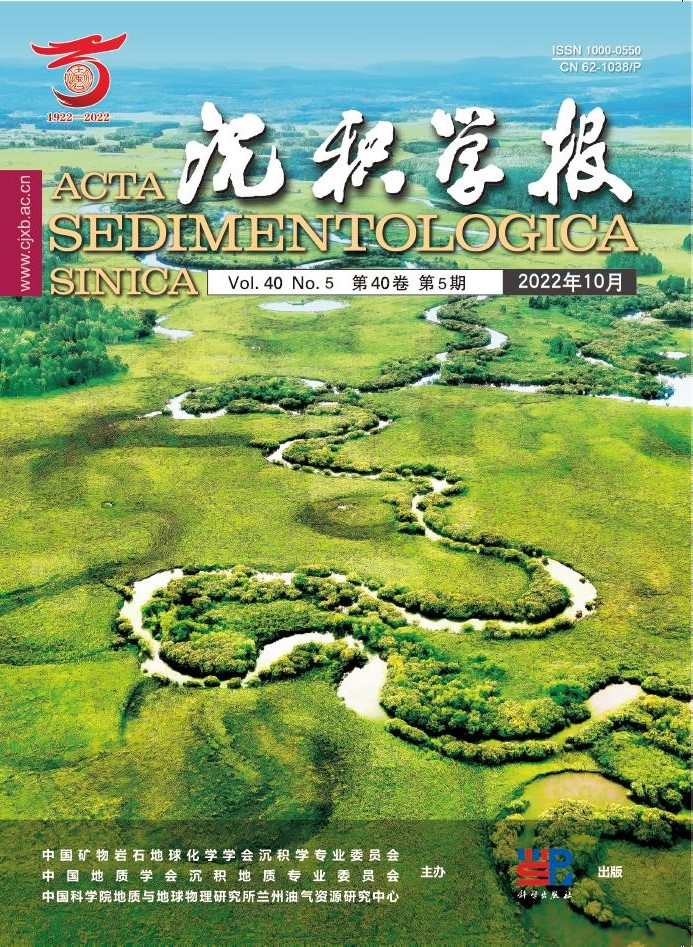


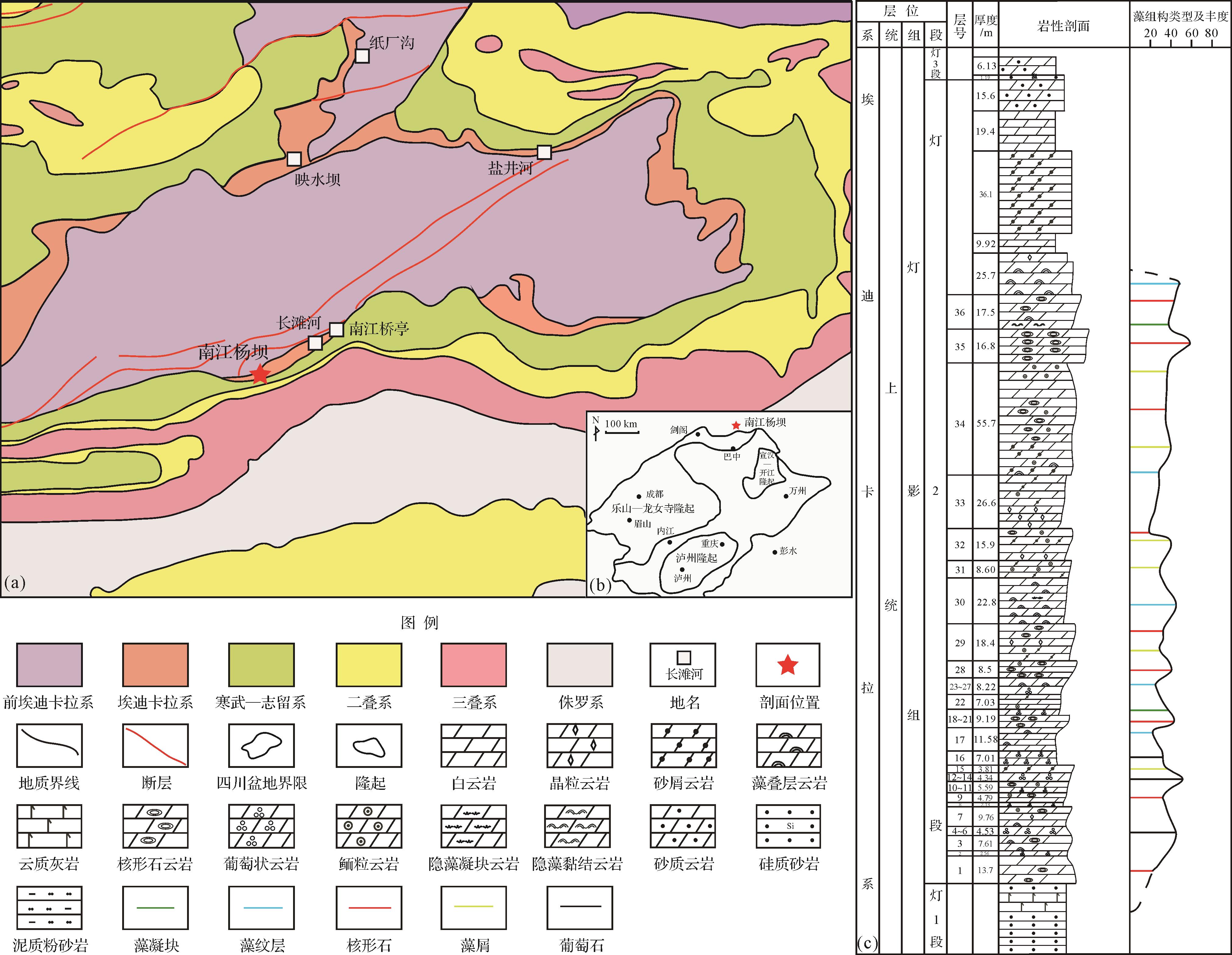









 DownLoad:
DownLoad:
